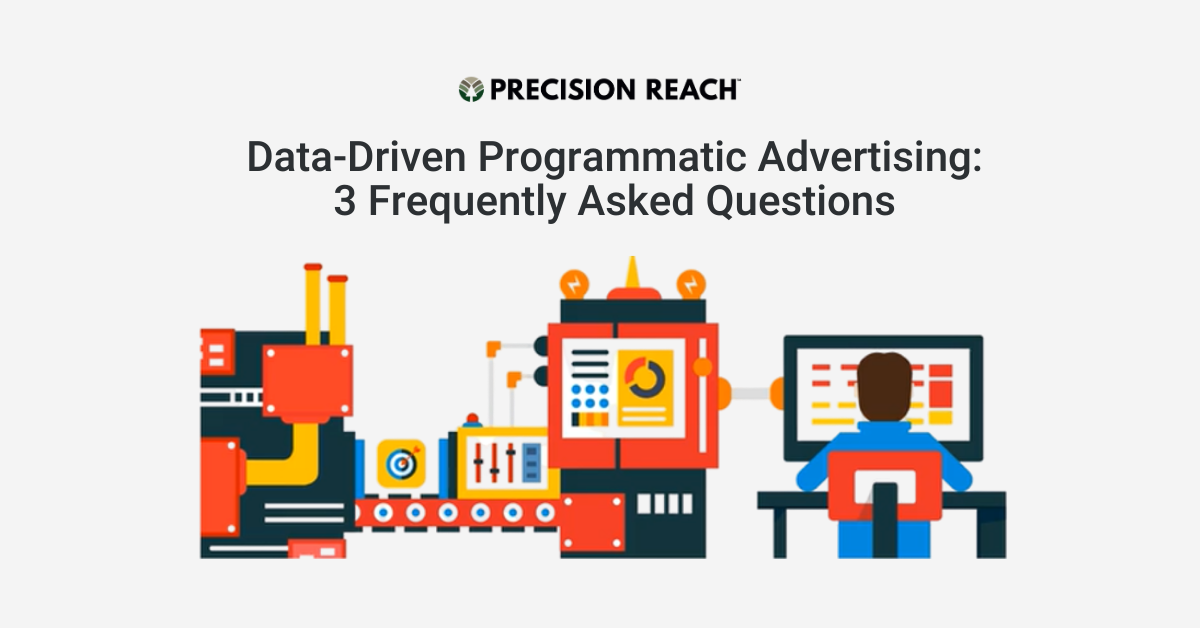
Since the advent of programmatic display advertising over ten years ago, the AdTech industry has seen enormous growth, with programmatic advertising now representing the primary method of buying digital media in the U.S, according to eMarketer.
The research firm estimates US advertisers will spend nearly $69 billion on programmatic display ads by the end of 2020. In 2021, they forecast nearly 88%, or $81 billion, of all U.S. digital display ad dollars will transact programmatically.
In particular, data-driven programmatic digital media tactics like display banners, pre-roll video, native ads and Connected TV have reached unprecedented adoption in recent years as marketers seek more precise targeting with less ad waste. Especially in B2B markets like Agriculture where there’s smaller audiences spread over diverse demographics from row crop to specialty crop to livestock farms.
Here are three common frequently asked questions around the topic of data-driven programmatic advertising.
1. What exactly is data-driven programmatic?
Programmatic advertising is the process of purchasing digital ad space (display banners, pre-roll video, native, connected TV) in real-time, with the assistance of dedicated software and algorithms that automate the process.
With data driven programmatic (DDP) buying, exclusive segmented audience data is integrated into the programmatic process to efficiently and effectively serve ads to a highly targeted audience across a variety of mediums.
For agri-marketers, custom data segments are set up and distributed into the buying platform. At Precision Reach – with the Farm Journal complete database onboarded and matched to farmers and ranchers desktop, tablet and mobile devices – we pull a custom list based on demographics like crop/livestock and acreage/herd size with the states, counties or zip codes of your target prospects.
2. How does DDP compare to “lookalike modeling”?
A general definition of Lookalike Audience is an “algorithmically-assembled group of individuals who resemble, in some way, another group of members”.
In this age of digital advertising, it refers to a targeting tool, which helps to reach potential customers online who are likely to share similar interests and behaviors with existing customers.
The primary objective is to find new people who are likely to have an interest in your business or brand. As a targeting tactic, lookalike campaigns will typically deliver more impressions to a relevant audience that is likely to click and convert. This is a very common practice for brands targeting large consumer markets like health and fashion products.
In comparison, a data-driven digital campaign has a pre-defined target audience where their devices have been identified for your ad delivery. Especially powerful for B2B markets where you have smaller, niche audiences to sell like we see in agriculture.
3. Is there a difference in advertising costs for data driven programmatic?
Yes, the CPM (cost per thousand ad impressions) will typically be higher when running data programmatic ad campaigns as compared to lookalike audience targeting. This is due to the additional expenses from:
- Data Management Platform fees. The cost to onboard, device match and continuously update the data files. The DMPs also have minimum monthly fees based on how many “activated records” you have in play.
- Data Provider fees. Unless it is your data, there are costs paid to the first- and third-party data providers for the programmatic use of their audience records. This is based on total number of ad impressions run for each campaign.
- Higher ad bid costs. The auction clearing price is higher because audience size is much smaller, more targeted. The specific precise 1st party audience is many multiples smaller in size than a look-a-like audience. The laws of supply and demand result in the higher clearing prices and the need to be bid more to win those impressions. Of course, the benefit is every impression is reaching an ideal prospect. A look-a-like audience campaigns suffer from tremendous waste, often greater than 90%.
To learn more how we at Precision Reach utilize the first party ag data, click here.